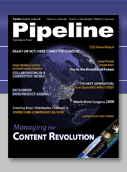|
|

article
page | 1 | 2 | 3 | 4 | provide an answer for operating in a partial deployment scenario.
Telcos are figuring out quickly that IMS isn’t really necessary for delivering on-demand services. Cable MSOs can demonstrate this fact with one touch of a button that allows subscribers to view movies or TV programs, request specific information, or to shop on-demand. IMS also isn’t necessary for cross-domain services. Any mobile subscriber who accesses his or her business email through a simple handset can attest to this, as can any Slingbox owner who watches his cable TV content remotely from his laptop. IMS similarly isn’t necessary for delivering personalized services in real-time. Service management capabilities, however, will be necessary to create a more secure and better accounted distribution channel than the Internet or raw broadband pipes offer today. Service management platforms must connect back office systems that manage subscriber-related data with devices, equipment, and application servers in the network that execute policies, collect usage information, and conduct complex service delivery.
|
|
The Open Cable Application Platform (Open Cable), a CableLabs-derived technology that is slated to roll out later in 2008, is intended to enable interactive advertising in the foreseeable future. |
|

To content partners, advertisers and enterprises, this translates into the kind of smart distribution and transactional channels they want and expect from telcos and mobile operators. They’re willing to pay a premium for this kind of capability because they can monetize it and measure the value it has for their businesses. For telcos and mobile operators, there’s an opportunity here to step up to this challenge. In a positive light, it’s really a matter of delivering the next level of process automation that many current OSS/BSS transformation and integration programs are already aiming for and are already resourced to provide.
Capitalizing on Interactive Advertising
On the consumer side, a major motivating
|
|
|
|

Today, systems in the network like gateways, routers, and Ethernet switches, usually take commands from engineers and static policy databases. Though IP and Ethernet networking systems can do more, they are often set up in a static mode that reflects the mechanized provisioning that has always been used to nail up and tear down TDM pipes. IP and Ethernet end up emulating the physical pipes of old, like DS3s, and only provide the value of cost savings. They are capable, however, of changing their characteristics and connectivity in response to real-time instructions.
If current networking technologies are taking orders from service management systems that can provide them with the right information, policies, permissions, and configuration commands in real-time, they’re entirely capable of enabling fluid, dynamic, and seemingly personalized service environments.
|
|

factor for telcos to step in this incremental direction is the allure of interactive advertising and the revenue it has the potential to deliver. Cable MSOs are already moving in this direction and are working on the ability to deliver clickable overlay ads, or even clickable product placements that enable instant purchasing. They aren’t far from enabling their subscribers to pull down more compelling information about the products they see on television. This is really just another form of transaction and e-commerce enablement, not dissimilar to what have become globalized ATM and POS transactions.
The Open Cable Application Platform (Open Cable), a CableLabs-derived technology that is slated to roll out later in 2008, is intended to enable interactive advertising in the foreseeable future. Telcos need to take note of and learn from what MSOs are doing in this
article
page | 1 | 2 | 3 | 4 | |
|
|




